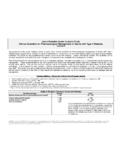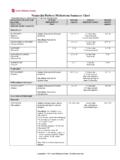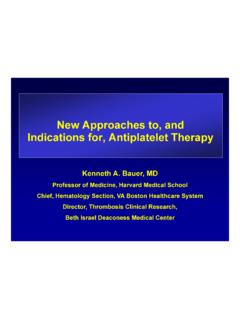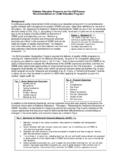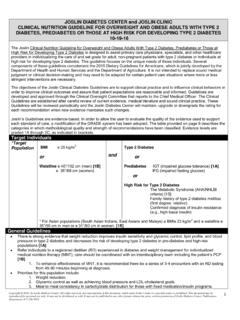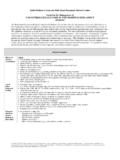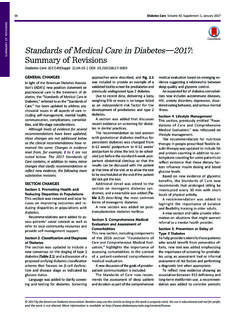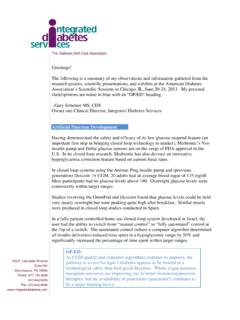Transcription of SURGERY ALGORITHM FOR PATIENTS WITH …
1 Copyright 2015 by Joslin diabetes Center. All rights reserved. Any reproduction of this document which omits Joslin s name or copyright notice is prohibited. This document may be reproduced for personal use only. It may not be distributed or sold. It may not be published in any other format without the prior, written permission of Joslin diabetes Center, Publications Department, 617-226-5815. 1 JOSLIN diabetes CENTER and JOSLIN CLINIC GUIDELINE for INPATIENT MANAGEMENT OF SURGICAL and ICU PATIENTS with diabetes (Pre-, Peri- and Postoperative Care) 12-30-2015 The Joslin Clinical Guideline for Inpatient Management of Surgical and ICU PATIENTS with diabetes is designed to assist primary care physicians and specialists individualize the care and set goals for adult, non-pregnant PATIENTS with diabetes who are undergoing SURGERY . This guideline focuses on the unique needs of the patient with diabetes .
2 It is not intended to replace sound medical judgment or clinical decision-making and may need to be adapted for certain patient care situations where more or less stringent interventions are necessary. The objectives of the Joslin Clinical Guidelines are to support clinical practice and to influence clinical behaviors in order to improve clinical outcomes and assure that patient expectations are reasonable and informed. Guidelines are developed and approved through the Clinical Oversight Committee that reports to the Chief Medical Officer of Joslin diabetes Center. The Clinical Guidelines are established after careful review of current evidence, medical literature and sound clinical practice. This Guideline will be reviewed periodically and modified as clinical practice evolves and medical evidence suggests. Joslin s Guidelines are evidence-based. In order to allow the user to evaluate the quality of the evidence used to support each Guideline for care, a modification of the GRADE system has been adopted.
3 The table provided on page 10 describes the categories in which methodological quality and strength of recommendations have been classified. Evidence levels are graded 1A through 2C, as indicated in brackets. Where evidence is not graded, recommendations are made based on the expertise of the Clinical Oversight Committee. SURGERY ALGORITHM FOR PATIENTS with EXISTING diabetes I. PREOPERATIVE MANAGEMENT General Considerations: Aim for early morning SURGERY : Scheduling early morning SURGERY may decrease the risk of hyperglycemia and hypoglycemia resulting from the disruption in typical medication and food schedules. Refer to the diabetes educator as soon as feasible. All hospitalized diabetes PATIENTS need an assessment of their diabetes knowledge in order to help insure their safety after discharge. See Joslin s Guideline: Uncontrolled Glucose in the Hospitalized Patient for more detail.
4 Morning and Afternoon Prior to SURGERY Management of insulin, oral glucose lowering medications and non-insulin injectable diabetes medication: o Maintain usual meal plan and insulin dose (NPH, glargine, detemir, regular, aspart, glulisine, lispro), insulin via continuous subcutaneous insulin infusion pump (CSII); 70/30, 75/25, 50/50 insulin, or human insulin inhalation [1C] and/or oral glucose lowering medications and/or non-insulin injectable diabetes medications (GLP-1 agonists and pramlintide). [1C] Evening Prior to SURGERY Management of insulin: o Basal insulin: Consider a 10-20% reduction in the usual dose of long-acting (glargine or detemir) insulin. If NPH insulin is given at bedtime, consider a dose reduction of 50%. o Insulin pump (CSII): PATIENTS can continue their usual basal rate. The infusion set insertion site should be placed away from the surgical site and can otherwise be placed anywhere on upper outer thighs, upper arms, or abdomen (2 inches away from umbilicus), [1B] Morning of SURGERY Management of insulin: o Basal insulin: If fasting after midnight, give 50% of the usual morning dose of intermediate (NPH) insulin.
5 If the patient usually takes a dose of long-acting insulin (glargine or detemir) in the morning, consider a dose reduction of 10-20%. o Bolus Insulin: Omit morning rapid- or short-acting insulin (including inhaled insulin) [1A], exception is pump users who may use corrective insulin per individualized instructions Copyright 2015 by Joslin diabetes Center. All rights reserved. Any reproduction of this document which omits Joslin s name or copyright notice is prohibited. This document may be reproduced for personal use only. It may not be distributed or sold. It may not be published in any other format without the prior, written permission of Joslin diabetes Center, Publications Department, 617-226-5815. 2 o Mixed basal/bolus: If the patient usually takes morning pre-mixed insulin (70/30, 75/25, 50/50) and is NPO, the optimal regimen would be to give 50% of the NPH component of the usual dose of premixed insulin and no rapid- or short-acting insulin.
6 [1B] Management of Oral Glucose-Lowering Medications and Non-insulin Injectable diabetes Medications: o Omit oral antidiabetes medications and non-insulin injectables (GLP1 agonists, and pramlintide) the morning of SURGERY [1A] Frequency of Blood Glucose Monitoring: o Check blood glucose level every 2 hours starting before SURGERY and continue during and after the SURGERY [1C] Arrival at Pre-Anesthesia Unit Glycemic Management: o Check blood glucose every 2 hours before SURGERY [1C] o Start IV insulin for PATIENTS undergoing major SURGERY ( , chest or abdominal cavity, vascular bypass, transplant, spinal or brain SURGERY requiring general anesthesia, total hip or knee replacement, SURGERY anticipated to be longer than 4 hours) II. INTRAOPERATIVE MANAGEMENT General Considerations: This section on intraoperative management contains GENERAL information on intraoperative management.
7 Section VI contains detailed algorithms on intraoperative management. A number of well-validated intraoperative insulin infusion protocols have been shown to work effectively. Section VI contains four sample algorithms, two designed to target BG levels of 100-180mg/dl for the non-critically ill patient, and two others to target BG levels of 140-180 mg/dl for the critically ill patient. Glycemic Management Check blood glucose every 2 hours during SURGERY [1C] Blood glucose level and type of SURGERY determine the frequency of additional blood glucose checks and treatment as outlined in Table 1 below. Insulin pump (CSII) PATIENTS can maintain basal rate during SURGERY [1C] or be changed to IV insulin infusion [1B] or subcutaneous basal insulin injections to maintain blood glucose target. [1B] Maintenance of Hydration During SURGERY the patient should receive maintenance IV fluids without dextrose ( LR or NS or NS rather than D5LR).
8 [2C] If an insulin infusion is required, D5W at 40 ml/hr or D10W at 20 ml/hr should be started in a separate IV line to provide adequate substrate. PATIENTS receiving insulin infusion should receive at least 50 grams of glucose/24 hours. [1C] Table 1: Type of SURGERY Major SURGERY , chest or abdominal cavity, vascular bypass, transplant, spinal or brain SURGERY requiring general anesthesia, total hip or knee replacement, SURGERY anticipated to be >4 hours Non-Major SURGERY , patient able to consume usual meal plan post-operatively Start IV Insulin [1A] (See Pre-, Intra- and Postoperative IV Insulin Infusion ALGORITHM pg. 5-8) BG <80 mg/dl Consider an IV bolus of at least 100 ml of D10W or 25 50 grams of D50 Check BG in 15-30 min. [1C] BG 80-100 mg/dl Begin IV of D5W at 40 ml/hour or D10 W at 20 ml/hour Check BG in 1 hour[1C] BG 101-180 mg/dl Continue to monitor blood glucose every 2 hours [1C] BG >180 mg/dl Begin IV insulin (See Pre-, Intra- and Postoperative IV Insulin Infusion ALGORITHM pgs.)
9 5-8 or subcutaneous insulin ALGORITHM pg. 3 [1C] Copyright 2015 by Joslin diabetes Center. All rights reserved. Any reproduction of this document which omits Joslin s name or copyright notice is prohibited. This document may be reproduced for personal use only. It may not be distributed or sold. It may not be published in any other format without the prior, written permission of Joslin diabetes Center, Publications Department, 617-226-5815. 3 III. IMMEDIATE POSTOPERATIVE MANAGEMENT Glycemic Management Check blood glucose when patient returns to post-anesthesia unit [1B]; base frequency of checks on blood glucose levels during SURGERY [1C] Administer insulin according to subcutaneous ALGORITHM (Table 2.) [1B] o For glucose level >180 mg/dl, check hourly [1C]; if no improvement in glycemic control, consider insulin dosing according to next higher weight class.
10 [1C] (see chart below) o Check glucose every 4-6 hours if using regular insulin (short-acting) [1C] o Check glucose every 2-4 hours if using aspart, glulisine, or lispro (rapid-acting) [1C] Table 2: Subcutaneous Insulin ALGORITHM Weight Class I (<175 lbs/80 kg) Weight Class II (175-220 lbs/81-99 kg) Weight Class III (>220 lbs/100 kg) BG (mg/dl) Insulin Units (subcutaneously) Insulin Units (subcutaneously) Insulin Units (subcutaneously) <180 0 units 0 units 0 units 181-200 1 unit 2 units 4 units 201-250 2 units 4 units 6 units >250 Begin insulin infusion Begin insulin infusion Begin insulin infusion IV. POSTOPERATIVE MANAGEMENT for NON-CRITICAL, NON-CARDIAC SURGERY PATIENTS Meal Planning: Meals should be advanced as tolerated and carbohydrates should be consistent for each meal. Blood Glucose Goals: Fasting and premeal blood glucose: 100-140 mg/dl Random or bedtime blood glucose: <180 mg/dl Glycemic Management Oral agents and non-insulin injectables: o Consider starting basal-bolus therapy as outlined below under Insulin Calculation.

